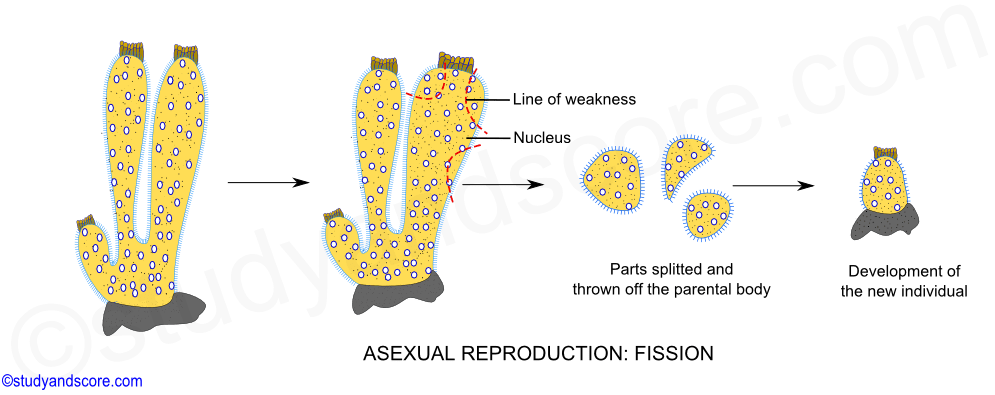Describe the Process of Sexual Reproduction in Sponges.
Asexual reproduction includes budding reduction bodies and gammae in sponges. There are 2 types of reproduction in Sponges.

Reproduction In Sponges Youtube
All sponges are hermaphrodites meaning that they can produce both egg and sperm but they ca nt fertilize themselves.
. There is another process of reproduction which is a sexual reproduction which takes place by the exchange of the garments and fusion. Then when it reaches female. Sexual reproduction is the formation of a new organism by the fusion of gametes - an egg and a sperm cell.
The first method of reproduction is the Asexual Reproduction which takes place by the formation of bud. - The sperm are released into the water and finds an egg to fertilize. Although most sponges are hermaphrodite but cross-fertilization is the rule because eggs and sperms are produced at different times.
They reproduce sexually and asexually. Larva swims somewhere else and settles down and inverts on a rock and grows. All sponges are hermaphrodite and most are protandrous so that cross-fertilization is probably the rule.
- larva looks different from adult sponge. Though some unisexual sponge species are also known most sponges are monoecious or bisexual. Sexual reproduction involves fusion of gametes.
Describe their sexual reproduction. Sperm are released into the surrounding water through the osculum. Most sponges are hermaphrodites possessing both eggs and sperm.
There are two methods of reproduction which can be possible for the sponge us. One amoeboid cell divides many times to form a mass of small tailed perm. -A larva is formed after fertilization.
Asexual reproduction includes budding reduction bodies and gammae in sponges. It is of 5 types. Oocytes arise by the differentiation of amoebocytes and are retained within the spongocoel whereas spermatozoa result from the differentiation of choanocytes and are ejected via the osculum.
The sex cells arise either from archaeocytes or choanocytes. So the male sponge basically releases sperm into water. In plants and certain animals like tapeworm Earthworm starfish a single individual has both male and female sex.
By Formation of Reduction Bodies. After fertilization the zygote becomes invested with a layer of the parents cells. If they enter a female sponge through a pore they may be trapped by collar cells.
Sponges reproduce asexually or sexually. However during the adverse. The larvae are flagellated and swim about freely for a short time.
-A sponge can reproduce sperm and egg cells. After developing gametes the male sponge will release its sperm into its canals. It may also be achieved asexually by fragmentation in which a detached piece of an adult sponge develops into a new organism.
Sexual reproduction involves formation of sperms and ova. There are two things plays important role in sexual reproduction obviously male and female spomges. The sperm is then pumped out of the sponge and into the surrounding water by the osculum.
Briefly describe the process of sexual reproduction in the sponge include the difference between parenchymula and amphiblastula Male gives sperm out during reproductive time for most sponges then goes to female egg. Although most sponges are hermaphrodite but cross-fertilization is the rule because eggs and sperms are produced at different times. The sperm is usually produced by the male parent and the egg is produced by the female parent.
SEXUAL REPRODUCTION IN SPONGES. Sponges reproduce asexually or sexually. In a majority of animals like in human beings male and female sex organs are in different individuals.
The resulting zygote develops. Most sponges are hermaphroditic the same individual producing eggs and sperm but in some species the sexes are separate. Sponges may also reproduce asexually.
The sponges have a capability to reproduce sexually and asexually. The sex cells arise either from archaeocytes or choanocytes. Sexual reproduction also occurs.
The sponge life cycle includes sexual reproduction. Up to 24 cash back Sexual Reproduction-The process of sexual reproduction between sea sponges occurs in the mesohyl an acellular gel layer that is the innermost layer of the sponges body. In sexual reproduction they release sperm into the water in hopes that it will land inside another sponge and fertilize an egg cell.
They can also reproduce asexually through fragmentation budding. Sexual reproduction involves fusion of gametes. Despite the fact that adult sponges cannot move they are capable of sexual reproduction.
Sexual reproduction involves formation of sperms and ova. Sexual reproduction is a type of reproduction in which the two sexes namely male and female are involved. Sexual reproduction in sponges occurs when gametes are generated.
When the male gamate and female gamate fuse a larvae is formed. The sperm and ova are derived from the undifferentiated amoebocytes called as. Each ovum is formed from a single cell which enlarges and becomes spherical.
Despite this sexual reproduction most often occurs between sponges as opposed to within a single organism. A type of asexual reproduction found only in freshwater sponges occurs through the formation of gemmules clusters of cells surrounded by a tough. By Formation of Gemmules.
Sponges are capable of sexual reproduction through spawning. Although sponges are bisexual hermaphrodite cross fertilization occurs as a rule as the production timing of sperm and ova are different. All sponges that are produced asexually are exact clones of the parent sponge.
After settling and attaching to a suitable substrate the larvae develop into young sponges. Sperm cells are released into the water and depending. Such organisms are called unisexual.
Trapped sperm are delivered to eggs inside the female body where fertilization takes place. Here the water acts as a medium. Asexual reproduction is either by fragmentation in which a piece of the sponge breaks off and develops into a new individual or budding an outgrowth from the parent that eventually detaches.
It consists of 3 stages.

Phylum Porifera Sexual And Asexual Reproduction In Sponges And Regeneration In Sponges Study Score


Comments
Post a Comment